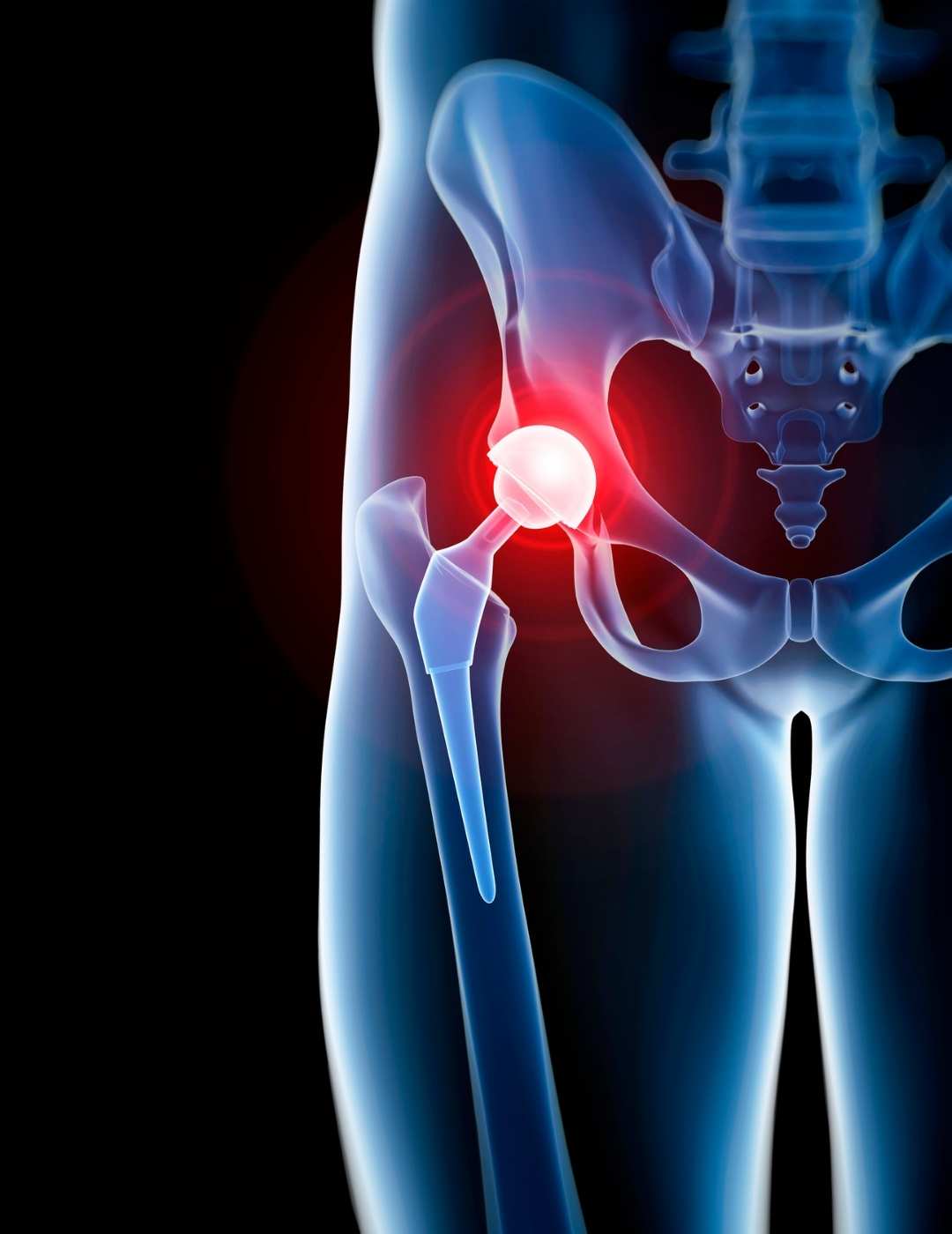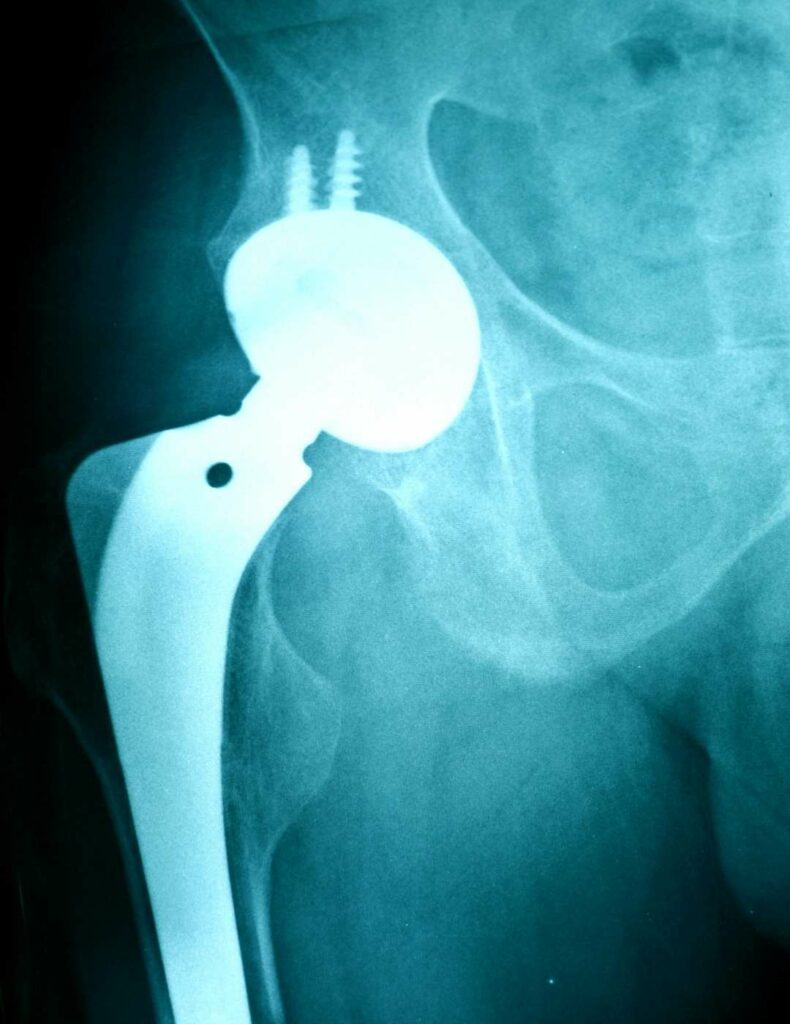Your Hip Replacement Surgeon In London
WHAT IS A TOTAL HIP REPLACEMENT?
A total hip replacement is a surgical procedure where both the ball and socket of the hip joint are removed and replaced with an artificial joint. The aim is to provides pain relief and in turn improve function.
WHEN IS A HIP REPLACEMENT SURGERY PERFORMED?
Hip replacements are primarily performed to treat pain and damage in the joint, with osteoarthritis being the most common underlying cause. Typically associated with the natural ageing process, hip joint wear and resulting pain can occur at any age. However, in younger patients, the reason is often attributed to factors such as abnormal hip joint structure, fractures, or childhood hip conditions.
Common signs and symptoms
Patients often present reporting the following:
• Pain in the groin +/- buttock
• A limp
• Stiffness
Hip pain can be challenging to diagnose, with some people presenting with knee and back pain.


HOW DO I KNOW IF A HIP REPLACEMENT MAY WORK FOR ME?
You will be asked specific questions about your symptoms, work, leisure activities and past medical history. You will also be asked if you smoke, as this increases the risk of infection and healing problems. A physical examination will also be required. X-rays are helpful to assess the degree of degenerative changes within the hip.
An MRI scan can be helpful to assess the degree of wear, however this is normally not necessary. It can be useful when weighing up if hip preservation surgery such as hip arthroscopy is still an option.
If after this a hip replacement is a treatment option, a specialist CT scan will be performed to allow for accurate virtual 3D patient planning to help locate of the hip replacement in the optimal
position based on the patient’s anatomy.
WHAT ARE THE TREATMENT OPTIONS?
Treatment options depend on a number of factors listed in the next section.
NON-SURGICAL TREATMENT:
Most people will have tried many treatments prior to presenting to their doctor.
• PHYSIOTHERAPY — Many people find their symptoms improve with a good rehabilitation
programme.
• PAIN KILLERS — There are a number of different pain medications that can help keep someone active and avoid surgery.
• INJECTIONS — Historically local anaesthetic and steroid injections would be performed to
delay surgery. There are now a number of different injections that can provide people with significant pain relief.
SURGICAL TREATMENT:
The aim of surgery is remove the damaged joint which is causing pain. Hip replacements are very successful operations with the vast majority of patients happy with their result.
HOW TO DECIDE ON TREATMENT?
Deciding what treatment is best for you can be difficult and will require a discussion with your hip replacement surgeon, Mr Webb, and your therapist.
Factors to take into account are:
- The duration of symptoms
- The impact the pain has on your day to day activities and quality of life
- Does the pain wake you at night?
- What treatments have been tired?
- Other medical conditions
- Current lifestyle/activities
- Smoking status
- Expectations.
HOW IS THE PROCEDURE PLANNED?
Mr Webb uses a system that allows for the procedure to be planned and performed virtually using virtual reality software. Adjustments are made to a patient specific virtual 3D model and once the optimal position of the hip replacement is determined, a bespoke surgical plan is made with the aim to reduce risk and optimise function. This process normally takes approximately 6 weeks.
What You Want To Know About Our Hip Replacement Surgery
A hip replacement surgery is performed by making an incision over the outer aspect of the hip. The hip is then dislocated and both the ball and socket of the hip joint are removed and prepared for the new hip to be inserted.
Mr Webb uses a replacement cup that bonds with your bone directly (uncemented). A liner is then inserted and is either made of ceramic or a hard wearing plastic. The thigh bone (femur) is then prepared to take a metal stem that sits inside the bone. This can either be uncemented or cemented depending on a number of factors including age, gender and the strength of the bone. A ceramic ball is then added to the top of the stem and the hip is then put back in joint.
CONSENT:
It is important that you understand the potential risks of surgery as well as the benefits. You will have the opportunity to go through these with Mr Webb. Prior to the procedure, an electronic consent form will be sent to you that goes through the risks in detail. Please do not hesitate to arrange an appointment to discuss any questions you have.
PREHABILITATION:
Mr Webb advises that you start a physiotherapy programme soon after your injury.
The aims of prehabilitation are to:
- Improve range of movement
- Muscle strength and control
- Practice using crutches
You will be asked to come to hospital where one of the nursing staff will prepare you for the procedure. The anaesthetist will meet you to discuss the type of anaesthetic and pain relief plan for after. Mr Webb will confirm the details of the procedure with you, answer any last-minute questions and draw an arrow on your leg.
The procedure normally takes approximately 1 to 2 hours. Once you have recovered from the anaesthetic, you go to the ward.
You will be seen by the physiotherapy team on the ward. As soon as you have recovered from the anaesthetic, you will be helped to sit up and walk. Most people are able to go home in the first couple of days. You can stop using crutches or sticks as comfort allows.
It is important to discuss the risks to ensure that you can assess whether surgery is right for you. The specific risks for hip replacement surgery include:
- INFECTION — this risk of infection is less than 1 in 100-200 cases. Antibiotics are routinely given at the start of the anaesthetic.
- BLOOD CLOTS — the risk of developing a blood clot is approximately 1 in 100. Clots in the leg (Deep Vein Thrombosis/DVT) can travel to the lung (Pulmonary Embolus/PE). Blood thinning medication will be prescribed to try to reduce this risk.
- PAIN — most people can experience pain following surgery.
- STIFFNESS — it is normal to feel stiff following the procedure. It is important to follow a rehabilitation programme.
- NERVE / BLOOD VESSELS — there are large blood vessels and nerves that run close to where the operation is performed.
- FRACTURE — there is a risk of breaking the bone around the hip joint. If this occurs during the operation, fixation will be attempted.
- DISLOCATION — a hip replacement is not as stable as a normal hip which means that the hip may dislocate in certain positions or following an injury.
- CHANGE IN LEG LENGTH — it is common to have a change in leg length following a hip replacement. Any change is usually not noticeable. Careful planning helps to reduce this risk.
It is normal to have pain and swelling following this type of surgery. There are cold therapy machines available to help reduce the swelling. It is a good idea to see your physiotherapist within the first week following your operation.
You should use ice/cold therapy and keep the leg elevated when you are resting.
The sticky dressings should remain on until the two week review even if blood stained. If they do come off they can replaced by any simple waterproof dressing.
If the waterproof dressings are intact you can shower, but do not soak the dressings and be careful not to slip or put too much weight through the operated leg. After your two week review, you can have a bath or swim.
You will be seen for a wound check and review at approximately two weeks following your hip surgery. If x-rays were not taken immediately after the operation, they will be taken at this point. You will then be offered another appointment six weeks after your operation.
Unleash Your Hip's Potential With Mr Mark Webb's Expert Hip Replacement Treatment
Are you struggling to perform simple tasks like getting up due to an overdue hip replacement? It’s time to seek help from a hip replacement surgeon. With Mr Mark Webb, you will receive specialized care and attention that hospitals may not always provide. As a leading expert in hip replacement, his dedicated focus and extensive experience ensure you receive the highest standard of tailored care. Embrace the opportunity to regain mobility, free yourself from discomfort, and step into a future full of vitality. Let Mr Webb and his dedicated team guide you on this transformative journey. Book your appointment now to discover a life of resilience, strength, and limitless possibilities.
